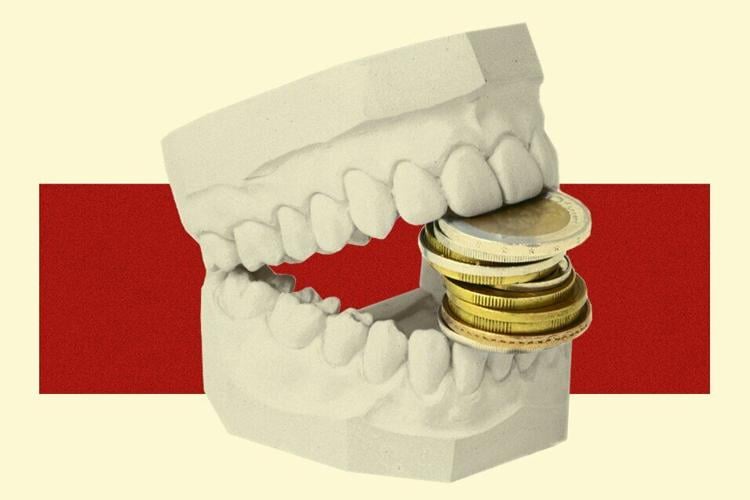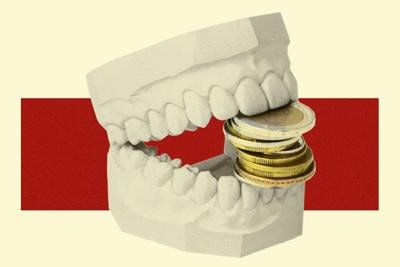Winnipeg resident, Olesia Romaniuk, 42, said she was incredibly excited when she found out she was approved for 100 per cent coverage under the Canadian Dental Care Plan, until she realized that 100 per cent comes with a few strings attached.
People trying to access the program and dentistry professionals say a federal program to cover dental care costs is leaving patients on the hook for part of the fees and that claims are being outright denied without explanation.
Wording on the government program is unclear and misleading, they say. Most notably, what the government lists as 100 per cent coverage of the costs of eligible services, does not align with fee guides which vary from province to province┬Āand patients are left having to cover the extra costs.
Further, dental offices are submitting claims for eligible services to Sun Life Financial, the insurance company handling the claims, but managers dealing with the submission are being denied without reason┬ĀŌĆö often after patients have already paid out of pocket for eligible services.
Administrative burden
In November 2024, the plan started using pre authorization for certain treatments, said David Brown, president of the Ontario Dental Association, representing dentists across the province. Procedures for crowns, bridges and some specialized treatments require dentist offices to get cases pre-approved, by sending in paperwork “which adds to the burden of the front desk,” said Brown. He added that many of the requests sent in “were taking weeks or days to adjudicate,” and were sent back, “not always approved.” The challenge with that, said Brown, is it leaves patients “potentially in pain for weeks or months, only waiting for the approval.”
Sun Life Financial declined a request for interview and told the Star to direct all questions on the program to Health Canada.┬Ā
In an emailed statement to the Star, a Health Canada spokesperson, Mark Johnson, said when a claim is denied, dental care providers are given clear explanations as to, “why the request was denied, including telling the provider if they didnŌĆÖt submit the required information, if the request didnŌĆÖt meet the clinical criteria outlined in the (program) Benefits Guide for that particular procedure or another rule wasnŌĆÖt met, if a frequency limit has been exceeded, or if the service is excluded/not available for coverage under the plan.”
‘It may as well be a grand’
Living with Lupus makes Romaniuk’s teeth brittle┬Āso when she heard people with disabilities could apply for 100 per cent coverage for eligible dental care services under the plan she applied right away┬ĀŌĆö and was accepted.┬Ā
While it was easy to find several dentists within walking distance of her home, Romaniuk said she was told by each office that she would be responsible for part of the cost.

Screenshot of the programs co-payments based on adjusted family net income, as seen on the website.
Canada.caTold she would have to pay between $35-60 for a cleaning ŌĆö as a person relying on disability benefits, Romaniuk said she had no choice but to skip out on the appointment she knows she needs.
ŌĆ£$35-60 may not seem like a lot but when your annual income on disability is less than $14,000 it may as well be a grand,ŌĆØ said Romaniuk.
Her monthly income after paying rent and bills, leaves her with about $200 to cover four weeks of food, all medication and any bus or travel expenses, said Romaniuk, adding even a load of laundry is $5 washed and dried. ŌĆ£So there just isnŌĆÖt $35 available after everything.ŌĆØ
Romaniuk said she feels the program needs to be more transparent┬ĀŌĆö clear with what services, if any, will be covered fully instead of giving people false hope.
Criteria were not met┬Ā
Mark Achbar, 69, based in British Columbia also qualified for the dental plan.
In November 2024, his dentist submitted a request for a crown to be covered and Achbar was given a temporary crown while waiting on pre-authorization for treatment.
Weeks later, Sun Life Financial requested more proof the procedure was necessary and said they needed more documentation, he said. Achbar worked with his dental office to send more information and they were told to wait “8 weeks,” and that “the clock restarted after each new request for more information.”
Meanwhile, Achbar had to pay to have gum surgery in order to make space for the new crown to adhere.
Five temporary crowns later, because they are only made to last weeks┬ĀŌĆö on May 4 ŌĆö 6 months after his dentist’s office put in the first request┬ĀŌĆö the request for coverage from Sun Life Financial was denied.
Sunlife would not specify why, exactly, his claim was denied. Just that ŌĆ£all criteriaŌĆØ were not met,” said Achbar, adding, “I still donŌĆÖt have my crown.”
Dental care providers asking for improvements
Since the program was introduced in May 2024,┬ĀThe Canadian Dental Association, representing oral health providers across the country, including the 80 per cent of dentistry offices in Ontario that work with the program, have advocated for improvements to the plan.┬Ā
In a written statement to the Star, a spokesperson for the Canadian Dental Association said many dentists are struggling with ŌĆ£administrative burdens and patient misconceptions about the plan, and ŌĆ”┬Āmany patients are encountering significant processing delays and issues with requests being denied, leaving patients with no access to care.ŌĆØ┬Ā
According to Canadian Dental Association surveys on the program, 80 per cent of dentists across the country said they have faced problems with pre-authorization requests, meaning that before some treatments can be provided┬ĀŌĆö even if they are deemed necessary by dentists┬ĀŌĆö the dentist’s office must first seek approval from the Canadian Dental Care Plan before they can move ahead with any procedures┬ĀŌĆö a lengthy process that doesn’t always authorize the care dentists are asking to provide to patients.┬Ā
Only 30 per cent of dentists said attempts for pre-authorization requests were approved, and 92 per cent said┬Āsignificant delays in processing times are impacting the patientŌĆÖs willingness to proceed,┬Āthe surveys said.
According to a Canadian Dental Association spokesperson, “Most dentists are balance-billing to cover the portion of the treatment cost that isnŌĆÖt covered by the (Canadian Dental Care Plan) which pays rates set by the federal government that are on average 85 per cent of the suggested fees in Ontario.”┬Ā “So, most patients with 100 per cent coverage (with income less than $70k) still need to be prepared to pay the 15 per cent that the plan does not cover. Patients with a co-pay of 40 or 60 per cent also have to cover that 15 per cent balance-billing charge.”
The Canadian Dental Association said they are ŌĆ£actively meeting with Health Canada to advocate for fixes and improvements to the pre-authorization process, as well as effective federal government communications, so that dentists can provide the care that patients need.ŌĆØ






























To join the conversation set a first and last name in your user profile.
Sign in or register for free to join the Conversation